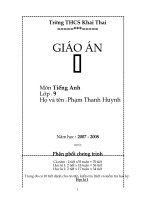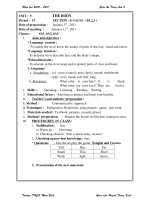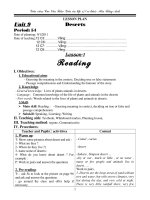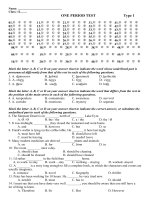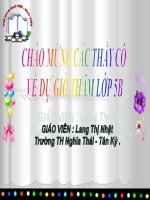Bài soạn TA 12 Unit 9 (C.Tien TQ)
Bạn đang xem bản rút gọn của tài liệu. Xem và tải ngay bản đầy đủ của tài liệu tại đây (286.45 KB, 14 trang )
Gi¸o viªn: Cao V¨n TiÕn- Gi¸o ¸n líp 12 (c¬ b¶n)- M«n TiÕng Anh
Lesson plan
Unit 9
Deserts
Period: 54
Date of planning: 9/1/2011
Date of teaching:12 C3:…………Vắng:…………………………………………………
12 C6:…………Vắng:…………………………………………………
12 C7: …………Vắng:…………………………………………………
12 C8:…………Vắng:………………………………………………..
Lesson:1
Reading
I. Oblectives:
1. Educational aims:
- Guessing the meaning in the context. Deciding true or false statements
- Passage comprehesions and Understanding the humour of the story.
2. Knowledge:
- General knowledge: Lives of plants animals in deserts.
- Language: Common knowledge of the life of plants and animals in the deserts
- New words: Words related to the lives of plants and animals in deserts.
3.Skill:
Main skill: Reading : - Guessing meaning in context, deciding on true or false and
passage comprehension
Subskill: Speaking, Listening, Writing
II. Teaching aids: Textbook, Whiteboard markes, Planning lesson,
III. Teaching method: regrate, Communicative
IV. Procedures:
Teacher and Pupils’ activitives Content
1. Warm up:
T: Show some pictures about desert and ask :
1- What are they ?
2- Where do they live ?)
3- name some of deserts :
4- What do you know about desert ? For
example :
P: Work in pairs and answer the questions
2. Pre-reading:
T: - ask Ss to look at the picture on page 96
and ask and answer the questions.
- go around the class and offer help if
necessary.
- Camel , cactus
-desert
-Sahara , Simpson desert …
-dry or wet , much or little , or no water ,
many or few people and animals live in
desert . …
Work in pairs.
1. Deserts are the large areas of sand without
tree and water, but with severe climates, very
hot during the day, and very cold at night.
There is very little rainfall there; very few
1
Giáo viên: Cao Văn Tiến- Giáo án lớp 12 (cơ bản)- Môn Tiếng Anh
I. Ask and answer the questions:
Suggested answers:
1. dry, few trees, little or no water, little
rainfall, few people and animals live in a
desert
2. camels, scorpions, cactus..
3. Egypt, Australia, China..
3. While-reading:
T: give some new words and ask them to
listen and repeat
P: listen and repeat and then take note on
their notebook
T: Ask students to read through the text once
to find out some new words, guess the main
idea.
- Explain new words (give the Vietnamese
equivalents), guide the sts to get the main
contents of the reading text.
- Ask students to work individually in 3
minutes to do this task.
Ask students to work individually in 3
minutes to do this task.
- Guide students to read through the passage ,
then focus on only the sentences surrounding
the suggested words to do the task
effectively.
T: Guides Ss the way to do Task 2 and ask
them to work in pairs
P: work in pairs and complete the excises
T: - Gets Ss to check theirs answers and
explain their choices.
- T calls some Ss to read theirs answers and
explain their choices.
- T comments and gives feedbacks.
people and animals live except foe in oases.
2. In a desert, only cacti and a kind of
spinifex can grow. No kind of animals can
live in deserts.
3. Australia, Mongolia, the USA, and in north
Africa have deserts.
II. Vocabulary:
- aerial (adj) ['e ri l] : trên không
- dune (n) [dju:n] : đụn cát
- stretch (n) [stret]: dải đất, dải nớc
- aborigine (n) [,ổb 'rid ini:z] : thổ dân úc
- hummock (n) ['h m k] : gò, đống
- slope (n) [sloup] : dốc, đờng dốc
- corridor (n) ['k rid :] : đờng hành lang
- crest (n) [krest] : đỉnh
- spinifex (n) ['spainif ks] : cỏ lá nhọn sống ở
vùng hoang mạc nớc úc
Task 1 : Give Vietnamese equivalents to ..
Keys:
1. Kéo dài, căng ra
2. Có cát,
3. Trắc lợng trên không
4. Hội địa lý hoàng gia Austra
5. Thổ dân Australia
6. Cồn cát, đụn cát
7. độ dốc, dốc thoai thoải
8. Dốc đứng, dốc ngợc
9. Gò, đống
10. Đỉnh (gò/đống)
11. Cỏ lá nhỏ mọc trên xa mạc
Task 2: Decide whether the following
statements are true (T) or false (F):
1. F (There are five: the Great Victoria, the
Gibbon, Great Sandy, Tanami and Simpson)
2. F (Simpson is the last part of Australia.
3. T (Until Madigan made an aerial survey
in 1929, he ...)
4. F (Colson and Australia Aborigine)
5. F (In the western ...., there is a network of
short dunes, and in the northern part ..., the
dunes are ...)
6. T (In the northern .... dry salt lakes ....)
Task3: Answer the following questions
2
Gi¸o viªn: Cao V¨n TiÕn- Gi¸o ¸n líp 12 (c¬ b¶n)- M«n TiÕng Anh
T: - Asks Ss to read the passage silently and
answer the questions individually
P: read the passage scilently and then answer
the questions
P:- Asks Ss to work in pairs to compare their
answers.
- Calls on some Ss to write the answers on
the board.
- Checks with the class.
- Gives feedback.
4. Post-reading:
* Read this story and answer the questions.
T: Ask Ss to work in pairs
P: read the passage and work in pairs
T:- Go around for help
- Call on some pairs to present
- Give comments .
1. There are Great Victoria Deserts, Gibbon,
Great Sandy, Tanami deserts and Simpson
Deserts.
2. It lies between Lake Eyre in the south, the
Macdonnel Ranges in the north, the Mulligan
and the Diamantia Rivers in the east and the
Macumba and Finke Rivers in the west.
3. In 1845
4. He was the president of the South
Autralian Branch of the Royal Geographical
Society of Australia.
5. They took camels across the desert.
6. In the west part, they are short, mostly less
than 10 meters high, and in the northern part,
they are parallel and are up to 20 meters
high.
7. two. They are hummock grasses and
spinifex
• Ss read the story silently, individually
and answer the following questions.
1. I think it is funny
2. desert (món tráng mi ng) and desert (saệ
m c)ạ
2. (It's the interpreter's pronunciation. He
pronunced the word "dessert" wrongly, which
made the American businessman
misunderstand him. That's really a great pity
or shame.
5. Home work: - Summarize the main points.
- Assign homework.
- Prepare new lesson.
6. Comment: ……………………………………………………………………………….
……………………………………………………………………………….
……………………………………………………………………………….
Lesson plan
3
Gi¸o viªn: Cao V¨n TiÕn- Gi¸o ¸n líp 12 (c¬ b¶n)- M«n TiÕng Anh
Unit 9
Deserts
Period: 55
Date of planning:9/1/2011
Date of teaching:12 C3:…………Vắng:…………………………………………………
12 C6:…………Vắng:…………………………………………………
12 C7: …………Vắng:…………………………………………………
12 C8:…………Vắng:………………………………………………..
Lesson:2
Speaking
I. Oblectives:
1. Educational aims:
- Explaining why some kind of trees and animals can exit in the deserts.
2. Knowledge:
- General knowledge: The lives of treas and animals in the deserts.
- Language: + The way to make the life better in the deserts.
+ The tenses.
3.Skill:
Main skill: Speaking
Subskill: Reading, Listening, Writing
II. Teaching aids: Textbook, Whiteboard markes, Planning lesson,
III. Teaching method: regrate, Communicative
IV. Procedures:
Teacher and Pupils’ activitives Content
1. Warm up:
T: - Ask Ss to discuss the questions.
→ Introduces the new lesson.
"In today s speaking section, you will’
practice Talking about natural
features of deserts"
2. Pre-speaking:
T: - Ask Ss to study the requirements
* Expected answers
- ……………..
Listen, look, guess, repeat, copy
New words:
Cactus (n)
Date-palm (n)
- camel (n)
4
What kind of
trees and animals
can live in deserts?
Gi¸o viªn: Cao V¨n TiÕn- Gi¸o ¸n líp 12 (c¬ b¶n)- M«n TiÕng Anh
in tasks then find out the new words
P: read the requests
T:- Help Ss with the vocabulary and
pronunciation
- Elicit some useful expressions:
Rub out and remember
3. While-speaking:
Task 1: Tick the trees and animals
that you think might exist in a desert
- Asks Ss to practice "ASK and
ANSWER" following the model
below:
- Students do as teacher’s
requirement.
P:- Students stand up and read aloud.
P:-Listen to the teacher and practice in
pairs
-Students divide in pairs.
Task 2: Find out natural features of
a desert.
T: - Guide Ss to do Task 2,
P: work in pairs and find out as much
as possible
T:- Ticks a poster to supply materials:
- Asks Ss to find out among them, what
are the natural features.
- Asks Ss to work in pairs
- Feed back: Give marks to better pairs
1. ‘eucalyptus (n) : cay khuynh diep
2. date palm (n) : cay cha la
3. ‘cactus (n) : cay xuong rong
4. ‘lizard (n) : con than lan
- Listen. - Read in pairs - Group works.
- Go to the board to match
Task 1: Tick the trees and animals……….
A: What animal can live in a desert?
B: I think it is ………(date palms, cactus, grass, camels
and lizards can exist in the desert)
A: Why can ……. live in a desert?
B: Because ………………….( they don't need a lot of
water and can survive under difficult conditions.).
A: What kind of trees can live in a desert?
B: I think it is ………( cacti and (hummock) grasses
A: Why can ………….. live in a desert?
B: Because …………( they can stand the severe climate
there)
Or
P1: What kinds of trees and animals on this list do
you think might exist in the deserts?
P2: I think date palm cactus, grass, camels and
lizards can exist in the desert.Because they don't
need a lot of water and can survive under difficult
conditions
P1: What about banana trees?
P2: I don't think they can live in such hot weather.
Task 2: Find out natural features……
Suggested answers:
hot, little rainfall, wet, sandy , dry, few people , much
sunshine, few animals , windy ,
NATURAL FEATURES
* Climate: - dry, hot, windy… very cold (night)
* Rainfall: - very little,
* People / animals: - few
* Sunshine: - much
* Soil: - sandy, hot
* Seasons: hot
Model:
In a desert, the climate is very different. It is
extremely hot all day and surprisingly cold in the
evening.
5
